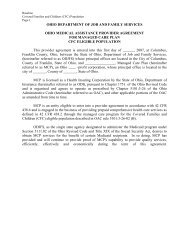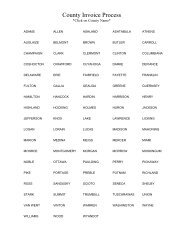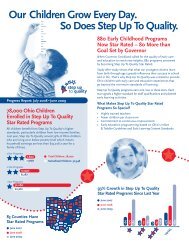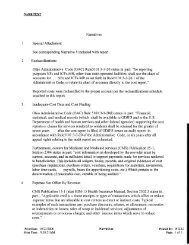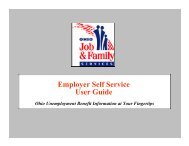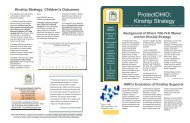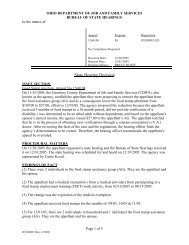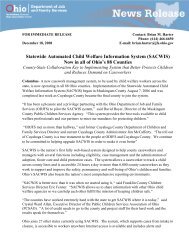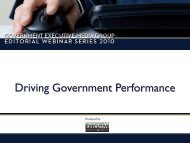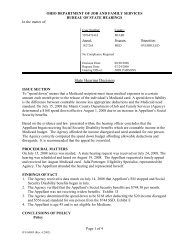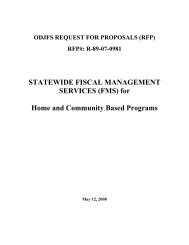Final TANF Rule as published in the Federal Register 4/12/1999
Final TANF Rule as published in the Federal Register 4/12/1999
Final TANF Rule as published in the Federal Register 4/12/1999
Create successful ePaper yourself
Turn your PDF publications into a flip-book with our unique Google optimized e-Paper software.
17862 <strong>Federal</strong> <strong>Register</strong> / Vol. 64, No. 69 / Monday, April <strong>12</strong>, <strong>1999</strong> / <strong>Rule</strong>s and Regulations<br />
however, objected to a large number of<br />
<strong>the</strong> proposed requirements.<br />
Commenters frequently provided<br />
extensive and detailed comments,<br />
<strong>in</strong>clud<strong>in</strong>g charts and tables <strong>as</strong><br />
attachments to <strong>the</strong>ir letters comment<strong>in</strong>g,<br />
<strong>in</strong> a parallel manner, on each of <strong>the</strong> data<br />
elements <strong>in</strong> <strong>the</strong> Appendices. We found<br />
<strong>the</strong>se comments, particularly those<br />
rais<strong>in</strong>g programmatic or adm<strong>in</strong>istrative<br />
concerns, very helpful.<br />
Summary of Changes Made <strong>in</strong> This<br />
Section of <strong>the</strong> <strong>F<strong>in</strong>al</strong> <strong>Rule</strong><br />
We have made several substantive<br />
changes <strong>in</strong> this section of rule and <strong>in</strong> <strong>the</strong><br />
data elements <strong>in</strong> <strong>the</strong> appropriate<br />
Appendices. In mak<strong>in</strong>g our decisions,<br />
we followed <strong>the</strong> general pr<strong>in</strong>ciples<br />
noted earlier, i.e., to collect <strong>the</strong><br />
<strong>in</strong>formation required by statute; to carry<br />
out our responsibilities under <strong>the</strong><br />
statute to <strong>as</strong>sure accountability and<br />
me<strong>as</strong>ure success; and to obta<strong>in</strong> data that<br />
are comparable across States and over<br />
time.<br />
First, we carefully considered each<br />
data element <strong>in</strong> each data collection<br />
<strong>in</strong>strument. Where possible, we have<br />
elim<strong>in</strong>ated, reduced <strong>the</strong> number of, or<br />
simplified <strong>the</strong> data elements or <strong>the</strong><br />
break-outs with<strong>in</strong> <strong>the</strong> data elements. In<br />
a few <strong>in</strong>stances, we have modified <strong>the</strong><br />
data collection <strong>in</strong>strument to expand a<br />
data element. (See <strong>the</strong> revised <strong>TANF</strong><br />
Data Report and <strong>the</strong> SSP–MOE Data<br />
Report <strong>in</strong> Appendices A through C and<br />
E through G.) We discuss some of <strong>the</strong><br />
specific changes and deletions below.<br />
Second, we elim<strong>in</strong>ated <strong>the</strong><br />
requirement for an Addendum to <strong>the</strong><br />
fourth quarter <strong>TANF</strong> F<strong>in</strong>ancial Report,<br />
but moved <strong>the</strong> content of <strong>the</strong> proposed<br />
Addendum, <strong>in</strong> paragraph (c)(2) and<br />
(c)(3), to § 265.9—<strong>the</strong> annual report<strong>in</strong>g<br />
requirements.<br />
Third, we accepted commenters’<br />
recommendations to revise our<br />
approach to and reduce <strong>the</strong> burden of<br />
<strong>the</strong> <strong>TANF</strong>–MOE (now <strong>the</strong> SSP–MOE)<br />
Data Report. We have:<br />
• Reduced <strong>the</strong> types of separate State<br />
programs covered by that report (This<br />
w<strong>as</strong> an <strong>in</strong>direct effect of <strong>the</strong> changes to<br />
<strong>the</strong> def<strong>in</strong>ition of <strong>as</strong>sistance, at § 260.31);<br />
• Reta<strong>in</strong>ed <strong>the</strong> requirement for<br />
report<strong>in</strong>g both disaggregated and<br />
aggregate data on recipients of<br />
<strong>as</strong>sistance under separate State<br />
programs under certa<strong>in</strong> circumstances,<br />
but have reduced <strong>the</strong> number of data<br />
elements that must be reported;<br />
• Deleted <strong>the</strong> provision that would<br />
have denied a State consideration for a<br />
reduction <strong>in</strong> <strong>the</strong> penalty for fail<strong>in</strong>g to<br />
meet <strong>the</strong> work participation<br />
requirements unless data on separate<br />
State programs w<strong>as</strong> submitted; and<br />
• Reduced <strong>the</strong> SSP–MOE data a State<br />
must file if it wishes to receive a high<br />
performance bonus (by elim<strong>in</strong>at<strong>in</strong>g <strong>the</strong><br />
requirement to submit section two of <strong>the</strong><br />
SSP–MOE Data Report, on closed c<strong>as</strong>es).<br />
See § 265.3(d)(1).<br />
Fourth, b<strong>as</strong>ed on <strong>the</strong> general<br />
pr<strong>in</strong>ciples above, we have determ<strong>in</strong>ed<br />
that a State h<strong>as</strong> <strong>the</strong> option to NOT report<br />
some data elements for some<br />
<strong>in</strong>dividuals <strong>in</strong> <strong>the</strong> family. We specify<br />
<strong>the</strong>se optional data elements <strong>in</strong> <strong>the</strong><br />
<strong>in</strong>structions to <strong>the</strong> <strong>TANF</strong> Data Report<br />
and <strong>the</strong> SSP–MOE Data Report. We have<br />
added a new paragraph (e) to § 265.3 to<br />
reflect this provision.<br />
Fifth, we added new paragraph (f) to<br />
specify <strong>the</strong> three circumstances when a<br />
State must report on a NCP. The three<br />
circumstances are:<br />
• When <strong>the</strong> NCP receives <strong>as</strong>sistance<br />
<strong>as</strong> def<strong>in</strong>ed <strong>in</strong> § 260.31;<br />
• When <strong>the</strong> NCP participates <strong>in</strong> work<br />
activities, <strong>as</strong> def<strong>in</strong>ed <strong>in</strong> section 407(d) of<br />
<strong>the</strong> Act, that are funded with <strong>Federal</strong><br />
<strong>TANF</strong> funds or State MOE funds; this<br />
would <strong>in</strong>clude work activities that fall<br />
under <strong>the</strong> def<strong>in</strong>ition of ‘‘<strong>as</strong>sistance’’ and<br />
those that do not; or<br />
• When <strong>the</strong> State h<strong>as</strong> designated <strong>the</strong><br />
NCP <strong>as</strong> a member of a family receiv<strong>in</strong>g<br />
<strong>as</strong>sistance.<br />
This latter circumstance addresses<br />
those States that wish to consider <strong>the</strong><br />
NCP a member of a family receiv<strong>in</strong>g<br />
<strong>as</strong>sistance <strong>in</strong> order to <strong>as</strong>sist <strong>the</strong> NCP by<br />
provid<strong>in</strong>g services or o<strong>the</strong>r activities<br />
that do not meet <strong>the</strong> def<strong>in</strong>ition of<br />
<strong>as</strong>sistance <strong>in</strong> § 260.31 or <strong>the</strong> def<strong>in</strong>ition<br />
of work activities <strong>in</strong> § 261.30. We have<br />
<strong>in</strong>cluded a requirement for report<strong>in</strong>g on<br />
<strong>the</strong>se NCPs <strong>in</strong> order to obta<strong>in</strong> data for<br />
policy, oversight, and o<strong>the</strong>r purposes.<br />
Where a State counts <strong>the</strong> NCP <strong>in</strong><br />
calculat<strong>in</strong>g <strong>the</strong> work participation rate,<br />
it should reflect its treatment of <strong>the</strong><br />
family <strong>in</strong> its cod<strong>in</strong>g of three data<br />
elements: ‘‘Type of Family for Work<br />
Participation Rate Purposes, Work<br />
Participation Status, and Work<br />
Activities.’’ We have added an element<br />
<strong>in</strong> <strong>the</strong> data <strong>in</strong>strument to capture such<br />
<strong>in</strong>formation about NCPs.<br />
Specific Changes Made <strong>in</strong> <strong>the</strong> Data<br />
Reports<br />
The follow<strong>in</strong>g changes are subject to<br />
review and approval under <strong>the</strong><br />
Paperwork Reduction Act.<br />
(a) <strong>TANF</strong> Data Report—Section One—<br />
Disaggregated Data on Families<br />
Receiv<strong>in</strong>g Assistance (Appendix A)<br />
(1) We reduced <strong>the</strong> number of data<br />
elements that must be reported from 106<br />
<strong>in</strong> <strong>the</strong> NPRM to 76 <strong>in</strong> <strong>the</strong> f<strong>in</strong>al rule.<br />
Some of <strong>the</strong> deleted data elements<br />
<strong>in</strong>clude:<br />
• Four data elements related to child<br />
care—Amount of Child Care Disregard,<br />
Type of Child Care, Total Monthly Cost<br />
of Child Care, and Total Monthly Hours<br />
of Child Care Provided Dur<strong>in</strong>g <strong>the</strong><br />
Report<strong>in</strong>g Month; and<br />
• Five types of Assistance Provided—<br />
Education, Employment Services, Work<br />
Subsidies, O<strong>the</strong>r Supportive Services,<br />
and Contributions to an Individual<br />
Development Account.<br />
Regard<strong>in</strong>g <strong>the</strong> deleted data elements<br />
on child care, <strong>in</strong> <strong>the</strong> NPRM, we<br />
proposed to collect <strong>in</strong>formation required<br />
by <strong>the</strong> Child Care and Development<br />
Block Grant Program (CCDBG). Upon<br />
fur<strong>the</strong>r analysis of that statute, we f<strong>in</strong>d<br />
that <strong>the</strong> data that must be collected and<br />
reported are aggregate data on <strong>the</strong><br />
number of child care disregards funded<br />
by type of child care service provider.<br />
Thus, we have made <strong>the</strong> revised<br />
collection of this <strong>in</strong>formation a part of<br />
<strong>the</strong> annual report <strong>in</strong> § 265.9(b)(4).<br />
(2) We fur<strong>the</strong>r reduced <strong>the</strong> report<strong>in</strong>g<br />
burden by revis<strong>in</strong>g several data<br />
elements. For example, <strong>in</strong> <strong>the</strong> data<br />
element on Sanctions, we deleted <strong>the</strong><br />
proposed requirement for expenditure<br />
data and, <strong>in</strong> <strong>the</strong> f<strong>in</strong>al rule, <strong>as</strong>k for a yes/<br />
no response. We also collapsed data<br />
elements such <strong>as</strong> <strong>the</strong> Number of Months<br />
Countable Toward <strong>Federal</strong> Time Limits.<br />
(3) We clarified <strong>the</strong> def<strong>in</strong>ition of ‘‘new<br />
applicant’’ and clarified report<strong>in</strong>g on<br />
waivers and noncustodial parents.<br />
(4) We provided flexibility <strong>in</strong><br />
permitt<strong>in</strong>g States to report some data<br />
elements b<strong>as</strong>ed ei<strong>the</strong>r on <strong>the</strong> report<strong>in</strong>g<br />
month or on <strong>the</strong> budget month.<br />
However, we require <strong>the</strong> State to be<br />
consistent <strong>in</strong> report<strong>in</strong>g <strong>the</strong>se data.<br />
In develop<strong>in</strong>g <strong>the</strong> NPRM, we<br />
proposed that all data elements be<br />
reported b<strong>as</strong>ed on <strong>the</strong> ‘‘report<strong>in</strong>g<br />
month.’’<br />
However, b<strong>as</strong>ed on a considerable<br />
number of comments and a review of<br />
<strong>the</strong> variation <strong>in</strong> State practice and State<br />
data collection and process<strong>in</strong>g systems,<br />
we concluded that, <strong>in</strong> some c<strong>as</strong>es,<br />
<strong>in</strong>formation on <strong>the</strong> budget month would<br />
be a good proxy for <strong>in</strong>formation on <strong>the</strong><br />
report<strong>in</strong>g month. Therefore, <strong>the</strong> f<strong>in</strong>al<br />
rule provides that States may report<br />
<strong>in</strong>formation on five data elements b<strong>as</strong>ed<br />
on ei<strong>the</strong>r <strong>the</strong> report<strong>in</strong>g month or <strong>the</strong><br />
budget month.<br />
We made this change for data<br />
elements that are relatively stable, e.g.,<br />
amount of Food Stamp <strong>as</strong>sistance and<br />
that o<strong>the</strong>rwise might not be reflected <strong>in</strong><br />
<strong>the</strong> State data systems. We believe that,<br />
<strong>as</strong> long <strong>as</strong> States report <strong>the</strong>se data<br />
consistently over time, this flexibility <strong>in</strong><br />
report<strong>in</strong>g will not compromise <strong>the</strong><br />
usefulness of <strong>the</strong> <strong>in</strong>formation. We are<br />
cont<strong>in</strong>u<strong>in</strong>g to require that seven data<br />
elements (e.g., amount of <strong>as</strong>sistance) be<br />
reported b<strong>as</strong>ed on <strong>the</strong> report<strong>in</strong>g month



